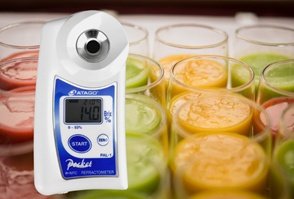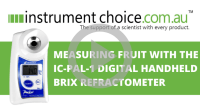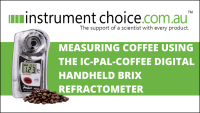How to Measure Brix Percentage in Juice Using the Atago IC-PAL-1 Digital Pocket Refractometer

The IC-PAL-1 Digital Pocket Refractometer by Atago Instruments has a wide Brix measurement range from 0 to 53%, making it a tool that's well-suited to measure almost any fruit juice, food, or drink. In this video article, we demonstrate how just how straightforward it is to take a Brix measurement in fruit juice using the IC-PAL-1.
How to Measure Brix Percentage in Juice Using the Atago IC-PAL-1 Digital Pocket Refractometer
Figure 1 Watch an Instrument Choice Scientist demonstrate how to measure the Brix percentage in juice samples using the IC-PAL-1 Digital Pocket Refractometer by Atago here.
Method
You will need:
- The Atago IC-PAL-1 Digital Pocket Refractometer
- A Pipette
- Water (Distilled or tap)
- At the start of each day, before taking a measurement, perform a zero calibration. To do so, turn the device on by pressing 'START' and ensure the sensor prism is clean.
- Apply enough water to cover the prism then press 'START' again. A measurement will appear within seconds.
- If the measurement is 0, take no action. If the measurement is not reading 0, press the 'ZERO' key.
- '000' will now appear on the screen.Wipe the water away from the prism. The meter is now ready to take measurements.
- Apply the juice you wish to measure onto the cleaned prism.
- Press the 'START' button.
- Within seconds the Brix result of the juice will appear on the screen.
- After use, always give the meter a clean. The IC-PAL-1 is water-resistant, making it simple to keep clean. Wipe dry before storing away for your next Brix measurement.
Conclusion
The operation and maintenance of Atago handheld pocket refractometers, including the IC-PAL-1 used in this video, is incredibly straightforward. For more information on this range of refractometers by Atago, or if you need a hand finding the best refractometer for your needs, contact us!
Additional links
- View the Atago IC-PAL-1 Digital Hand-held Pocket Refractometerhere.
- Browse the full range of Atago Refractometers
- Watch 'How to Measure Brix in Juice Samples using the IC-PAL-1' again.
Additional Videos featuring Atago Instruments
- Unboxing the IC-PAL-1 Digital Handheld Refractometer by Atago
- How to use the Data Transmission Function on Atago Pocket Refractometers
- Measuring Fruit with the IC-PAL-1 Digital Handheld Brix Refractometer
- Measuring Coffee Using the IC-PAL-Coffee Digital Handheld Brix Refractometer
- Measuring Honey Moisture Using the IC-PAL-22s Honey Refractometer
Also interesting
Brix is the measurement of the sugar content within a liquid solution. One degree Brix is equivalent to 1 gram of sucrose in 100 grams of the measured solution. Brix results display in degrees Brix (°Bx) or express as a percentage.
Brix refractometers are often used to measure sucrose levels within a wide range of food and beverage, including fruits, vegetables, condiments, juices, soft drinks, wine and beer. Brix Refractometers provide professionals a wealth of information at the touch of a button, giving insight to a product's taste, quality, and nutritional density.
The IC-PAL-1 handheld pocket refractometer by Atago makes it easy to measure Brix. This video article shows how to take a Brix measurement using the Atago IC-PAL-1 digital handheld Brix refractometer.

Coffee is arguably the world’s most popular addictive substance of choice. Consumers are becoming increasingly sophisticated, and as a result, many baristas are using scientific instruments to ensure the perfect brew!
It turns out that the Brix percentage indicates the typical strength of a coffee. This measurement provides a well-trained barista insights into the solubility of a roast, how to setup up their equipment, even how to achieve the perfect roast of coffee beans.
Are you interested in taking coffee brewing to the next level? The Atago IC-PAL-Coffee is a device Instrument Choice recommends to baristas, principally because the instrument is capable of determining a subtle difference in a coffee brew’s concentration to a high resolution of 0.01%! What's more, stable readings are possible, even at high temperatures, which is a result of the Atago’s continuous measurement feature.

